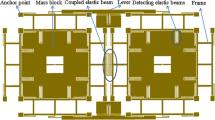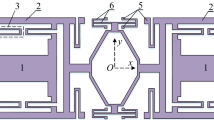Abstract
In this paper, a novel MEMS tuning fork gyroscope with anchored coupling mechanism is designed to analyze the mode ordering and vibration sensitivity. The proposed TFG prioritizes anti-phase drive-mode by using a levered mechanism while the sense-mode is prioritized utilizing an anchored coupling ring spring linked by four linear beams, which eliminates the lower frequency parasitic mode and provides true mechanical suppression of external vibration. In order to make a contrast with the proposed novel anchored coupling TFG, a conventional one with a direct coupling ring spring between two tines is also designed. The simulated frequencies of the in-phase and anti-phase in the sense mode are 4,006.8 and 4,463.5 Hz, respectively. Meanwhile, the in-phase frequency of the anchored coupling TFG is 5,958.4 Hz, improving by 48.7 %, and the anti-phase frequency is increased a little. Additionally, we carry out the FEM simulations on the vibration sensitivity induced by the stiffness imbalance for the two types of TFGs. Our results demonstrate that the vibration output is reduced by 74.8 and 88.1 % in the anti-phase mode and in-phase mode, respectively. Therefore, the novel anchored coupling TFG can provide improved mode ordering and substantially suppress the vibration output without compromising the scale factor.








Similar content being viewed by others
References
Alper SE, Akin T (2004) Symmetrical and decoupled nickel microgyroscope on insulating substrate. Sens Actuator A Phys 115(2):336–350
Geen J (2004) Progress in integrated gyroscopes. Proceedings Position, Location, and Navigation Symposium (PLANS), Monterey, pp 1–6
Guan YW, Gao SQ, Liu HP, Niu SH (2014) Acceleration sensitivity of tuning fork gyroscopes: theoretical model, simulation and experimental verification. Microsyst Technol. doi:10.1007/s00542-014-2185-9
Schofield A, Trusov A, Shkel A (2007) Multi degree of freedom tuning fork gyroscope demonstrating shock rejection. In: Proceedings IEEE SENSORS Conference, Atlanta, pp 120–123
Shkel AM (2006) Type I and type II micromachined vibratory gyroscopes. In: Proceedings position, location, and navigation symposium (PLANS), San Diego, pp 586–593
Singh TP, Sugano K, Tsuchiya T, Tabata O (2012) Frequency response of in-plane coupled resonators for investigating the acceleration sensitivity of MEMS tuning fork gyroscopes. Microsyst Technol 18(6):797–803
Singh TP, Sugano K, Tsuchiya T, Tabata O (2013) Experimental verification of frequency decoupling effect on acceleration sensitivity in tuning fork gyroscopes using in-plane coupled resonators. Microsyst Technol 20(3):403–411
Trusov AA, Schofield AR, Shkel AM (2008) A substrate energy dissipation mechanism in in-phase and anti-phase micromachined z-axis vibratory gyroscopes. J Micromech Microeng 18:095016
Trusov AA, Schofield AR, Shkel AM (2011) Micromachined rate gyroscope architecture with ultra-high quality factor and improved mode ordering. Sens Actuator A Phys 165(1):26–34
Walther A, Blanc CL, Delorme N, Deimerly Y, Anciant R, Willemin J (2013) Bias contributions in a MEMS tuning fork gyroscope. J Microelectromech Syst 22(2):303–308
Xie H, Fedder GK (2003) Integrated microelectromechanical gyroscopes. J Aerosp Eng 16:65–75
Zaman MF, Sharma A, Ayazi F (2006) High performance matched-mode tuning fork gyroscope. Proceedings MEMS, Istanbul, pp 66–69
Yoon SW, Lee SW, Perkins NC, Najafi K (2007) Vibration sensitivity of MEMS tuning fork gyroscopes. IEEE SENSORS Conference, pp 115–118
Yoon SW, Lee S, Najafi K (2012) Vibration-induced errors in MEMS tuning fork gyroscopes. Sens Actuator A Phys 180:32–44
Acknowledgments
This work is supported by the National High Technology Research and Development Program of China (Grant No. 2013AA041104).
Author information
Authors and Affiliations
Corresponding author
Rights and permissions
About this article
Cite this article
Guan, Y., Gao, S., Jin, L. et al. Design and vibration sensitivity of a MEMS tuning fork gyroscope with anchored coupling mechanism. Microsyst Technol 22, 247–254 (2016). https://doi.org/10.1007/s00542-014-2405-3
Received:
Accepted:
Published:
Issue Date:
DOI: https://doi.org/10.1007/s00542-014-2405-3




